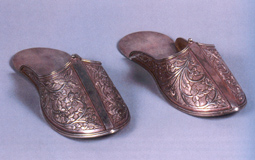
Art history/ Historiography, Museums/ Galleries / Collections / Exhibitions
The Tradition of Foot Covering in Indian Culture Upanah, Paduka, Juta Juti
Pathak, Anamika
Issue 01,Summer 2019
Issue 1, Summer 2019 ISSN: 2581 - 9410
Upanah, paduka (in Sanskrit), kharawan (in Hindi) or sandal has been a popular form of foot covering in Indian culture from the Vedic period onward. Juta and juti (in Urdu), chappal or morjari (in Hindi) these slippers and shoes are the few other types of foot covering that have plenty of references in classical Sanskrit literature and in Buddhist, Jain and in the Sangam Tamil literature from South India. Apart from literary references foot coverings have been beautifully depicted in Indian art too. In addition to literature and art, shoes got the highest reward of its importance in the Epic Ramayana and in Tamil culture, which has no parallel in any other culture of the world. The rich Indian classical and folk literature provides the fine details on the types of foot covering, the material and color used for making them shoes and the occasion of use and other related customs. On the other hand numerous miniature paintings show the variety of shoes and its users. So far, actual shoes of the museums and private collections are less reported. Therefore an attempt has been made here to discuss the shoe collection of the National Museum of India located in New Delhi. Before discussing the actual objects in detail, it will not be out of context to give the brief history of shoe tradition in Indian literature, art and its symbolic meaning.
Shoe tradition in literature
The ‘ Upanah' or 'Upanat' is the term used for sandal or s...
This is a preview. To access all the essays on the Global InCH Journal a modest subscription cost is being levied to cover costs of hosting, editing, peer reviewing etc. To subscribe, Click Here.



